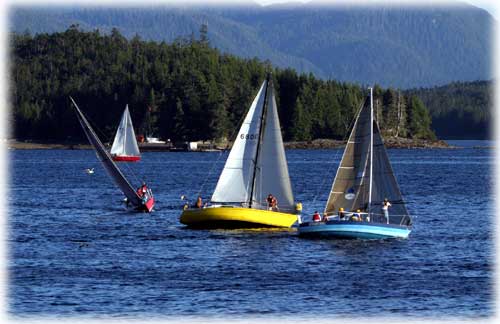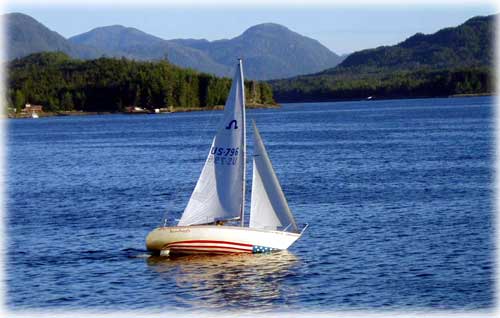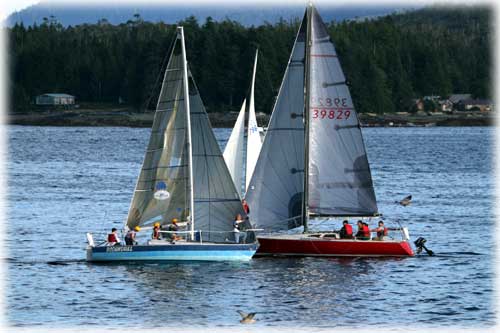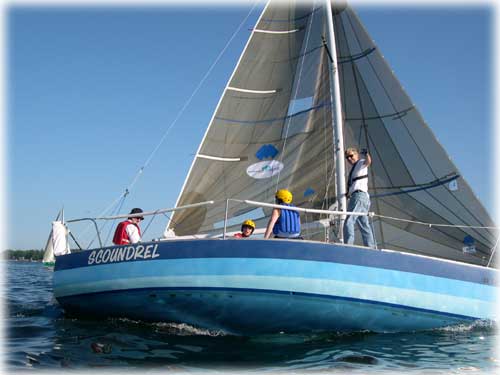 & Sportsmanship is the Rule - Part 3 by Mary Lynne Dahl August 20, 2004
 Photograph by Quie Emery
The most fundamental rules of sailing are classified into 5 categories: 1. Safety, 2. Fair Sailing, 3. Acceptance of the Rules, 4. Decisions to Race and 5. Drugs (an anti-doping rule). Following these broad categories are the more detailed and specific rules that apply when boats actually race. They are designed to indicate which boats have the right of way in any situation, how to avoid collisions with other boats, what the race course consists of in any given race, what kinds of racing behavior is allowed or disallowed during a race, how a race is scored, what penalties apply when rules are broken, and how to administer the rules and scoring. To start with, the most basic of rules is to avoid colliding with other boats. The rules of racing give "rights" to one boat over the other in every instance when boats are near each other during a race. This makes it possible to know when to give room to another boat that is approaching, crossing in front, or turning nearby.  Photo by Nancy Jensen
Another basic rule is that when racing, a boat may not touch a "mark". What is a mark? It is the channel buoy or temporary buoy placed in the water to mark the place on the race course where the boats are required to turn. This rule even prohibits the sails from touching the mark, not just the boat itself. A sailor whose boat, sails, equipment or crew touches a mark during any race will be penalized for that race without exception. In fact, the rules are so strict on this issue that if a boat gains a significant advantage by touching a mark, she is supposed to drop out of that race entirely.  Photograph by Quie Emery
Another important set of technical terms are those that identify the parts of the sails and the actions required to make the sails work properly. For example, to raise a sail you must pull on a line called the halyard, which is attached to the top of the sail. It runs from the top of the sail to a specific spot on the boat and needs to be pulled in order to raise the sail to its full position. Then, once raised, the line holding that sail up has to be locked down so that the sail stays put where it should be. Each action, and each piece of line (rope, for landlubbers) or equipment used in this task, has a unique name and usage. A "halyard" is drawn through the "head" (top) of the sail and is fastened down firmly in a locked position, either on a "winch" or through some type of block that holds it in place. At the loose end of the sail, which is the part that goes from side to side when the boat changes direction, another line is attached, called the "sheet". The sheet is adjusted to make the sail more efficient, which is called "trimming the sail". Wanna-be sailors may think that the technical jargon is mind-boggling and incomprehensible, making it a daunting task to figure out how to get that sailboat moving on the water, but this is not true. Sailing language is sort of like talking to a dog.there are only so many words that apply, so once you learn most of them you are in business! Racing rules, while very complex, do in fact have a common basis, which is safety (avoiding collisions), sportsmanship (no cheating) and fairness. These underlying themes are the foundation for all of the details of each rule, with a heavy dose of common sense as part of the total formula. So.. ahoy there mate! Pull that halyard, sheet that sail and move to the high side, because we are racing this sailboat in the Ketchikan Yacht Club Wednesday night sailboat races!
File photograph by Jim Dahl
Part 1 & Part 2 Articles:
|
